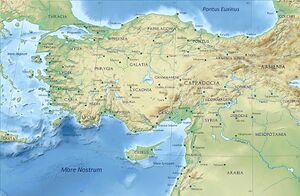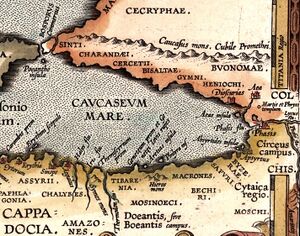Tibareni
| Author:Laxman Burdak, IFS (R) |

Tibareni were a people residing on the coast of ancient Pontus referred to in Herodotus, Xenophon, Strabo and other classical authors. The Tibareni were believed to be of proto-Kartvelian [1][2][3] or Scythian origin.[4][5][6][7]
Variants
- Tibareni (Pliny.vi.4 )
- Georgian: ტიბარენები
- Greek: Τιβαρηνοί[8] and Τιβαρανοί;[9])
- Tibarenebi
- Tibarenia (Ancient Greek: Τιβαρηνία) (country)
Jat Gotras Namesake
History
Tibareni occupied the country between the Chalybes and the Mosynoeci, on the east of the river Isis, and the country was called Tibarenia (Ancient Greek: Τιβαρηνία).[10] They are mentioned as early as the time of Herodotus,[11] According to the ancient Greeks, the Tibareni were Scythians.[12] Strabo describes them as inhabiting the mountains branching off from the Montes Moschici and Colchici, and mentions Cotyura as their principal town.[13][14] They appear to have been a harmless and happy people, who performed all their duties in a joyous manner.[15][16][17] Their arms consisted of wooden helmets, small shields, and short spears with long points.[18] Xenophon and his Greeks spent three days in travelling through their country.[19]
All three tribes — Tibareni, Chalybes and Mosynoeci — still neighbored each other, along the Black Sea coast of Anatolia (ancient Pontus), as late as in Roman times. Tibareni, along with the other Proto-Georgian tribes were subjugated by the Achaemenid Empire in the 6th-5th centuries BC and were incorporated into the XIX Satrapy.[20]
Mention by Pliny
Pliny [21] mentions The region of Themiscyra, and the nations therein...We find here the nations of the Genetæ7 the Chalybes8, the town of Cotyorum9, the nations of the Tibareni and the Mossyni, who make marks upon their bodies,....
7 Strabo speaks of a promontory called Genetes; and Stephanus Byzantinus mentions a river and port of the same name.
8 Strabo places the Chaldei, who, he says, were originally called Chalybes, in that part of the country which lies above Pharnacia (the modern Kerasunt).
9 Or Cotyora. According to Xenophon, this was a colony of Sinope, which furnished supplies for the Ten Thousand in their retreat. The place was on a bay called after the town. Hamilton, in his Researches, &c., Vol. i., is of opinion that Cotyorum may have stood on the site of Ordou, where some remains of an ancient port, cut out of the solid rock, are still visible. He remarks, however, that some writers suppose that Cotvora was the modern bay of Pershembah, which is more sheltered than Ordou. Cotyora was the place of embarkation of the Ten Thousand.
References
- ↑ Rapp, S. H., & Crego, P. (2011). Languages and cultures of Eastern Christianity. Ashgate.
- ↑ Morritt, R.D. (2010) Stones that Speak. EBSCO ebook academic collection. Cambridge Scholars Pub.](9781443821766) p.99
- ↑ Toumanoff, Cyril (1963). Studies in Christian Caucasian History. Georgetown University Press. p. 56.
- ↑ Schol. ad Apoll. Rhod. 2.378, 1010
- ↑ Xenophon. Anabasis. Vol. 5.5.2.
- ↑ Periplus of Pseudo-Scylax
- ↑ Stephanus of Byzantium. Ethnica. Vol. s.v. Τιβαρηνία.
- ↑ Stephanus of Byzantium, Ethnica, § T622.6
- ↑ Stephanus of Byzantium, Ethnica, § T622.6
- ↑ Stephanus of Byzantium, Ethnica, § T622.6
- ↑ Herodotus. Histories. Vol. 3.94.
- ↑ [ https://www.academia.edu/2951102/Tabal_an_out_group_definition_in_the_first_Millennium_BCE Lorenzo D'alfonso. "Tabal, an 'out-group' definition in the first Millennium BCE." 2012. p. 185.]
- ↑ Strabo. Geographica. Vol. xi. p.527. Page numbers refer to those of Isaac Casaubon's edition.
- ↑ Pliny. Naturalis Historia. Vol. 6.4.
- ↑ Schol. ad Apoll. Rhod. 2.378, 1010
- ↑ Stephanus of Byzantium. Ethnica. Vol. s.v. Τιβαρηνία.
- ↑ Anon. Peripl. P. E. p. 12; Pomponius Mela. De situ orbis. Vol. 1.19.
- ↑ Herodotus. Histories. Vol. 7.78.
- ↑ Xenophon. Anabasis. Vol. 7.8.25; Diodorus Siculus. Bibliotheca historica (Historical Library). Vol. 14.30; Dionys. Per. 767; Pomponius Mela. De situ orbis. Vol. 1.2.; Strabo. Geographica. Vol. ii. p.129, vii. p. 309, xi. p. 549, xii. p. 555. Page numbers refer to those of Isaac Casaubon's edition.
- ↑ Rayfield, Donald (2012). Edge of Empires: A History of Georgia. p. 19.
- ↑ Natural History by Pliny Book VI/Chapter 4
Back to Jat Places
